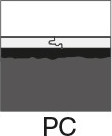Underlay features
In times of resource saving, thermal insulation is an important criterion. A properly insulated floor feels warm, even unheated. Underlay requirement: R ≥ 0.075 m2 K/W (for floor with HDF-core) and R ≥ 0,03 m2 K/W (for floor without HDF-core).
If the floor is to be laid on top of an underfloor heating system, the underlay must have the correct level of heat permeability. Heat transfer resistance should not exceed a value of 0.15 m² K/W in the entire structure (i.e. underlay and top layer). High thermal conductivity ensures that your rooms are heated efficiently. Maximum permitted EPLF value of the of the total floor: R ≤ 0.15 m2 K/W
‘Walking sound’ refers to the noises which are audible within the room. The unpleasant clack-clack effect can be greatly reduced by selecting the correct underlay.
‘Impact sound’ describes the noises that are heard in rooms below or adjacent. Depending on the material compound used in the underlay, impact sound can be reduced by up to 20 dB. Minimum EPLF requirement: IS ≥ 14 dB (for floor with HDF-core) and IS ≥ 10 dB (for floor without HDF-core)
Adequate pressure stability of the underlay is very important, particularly when laying click laminate floors. Minimum EPLF requirement: CS ≥ 10 kPa (for floor with HDF-core) and CS ≥ 200 kPa (for floor without HDF-core). We recommend a minimum load stability for underlays ≥ 90kPa (for floor without HDF-core).
A floor system is typically exposed to dynamic stress. The substrate must enable to withstand such repeated short-term loads with unchanged properties in the long term. Minimum requirement EPLF: DL ≥ 10,000 cycles.
The floors are often uneven, especially in old buildings. These irregularities can be levelled out with the right add2 parquet underlay. EPLF requirement: PC ≥ 0.5 mm
For mineral substrates floor manufacturers prescribe the installation of a vapour barrier (PE foil). Some our products have an integrated vapour barrier, so you can do without such foil. EPLF requirement: SD ≥ 75 m





